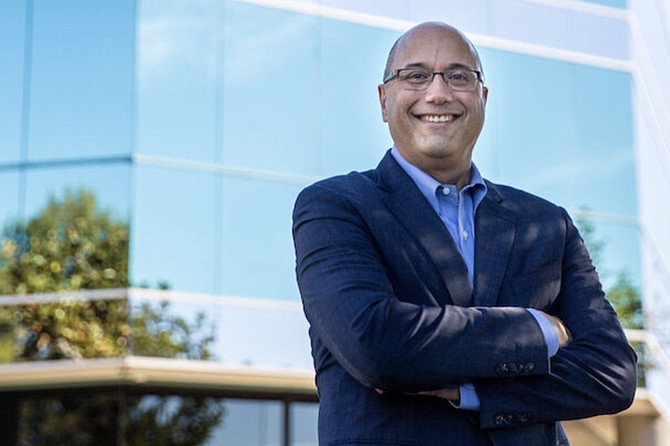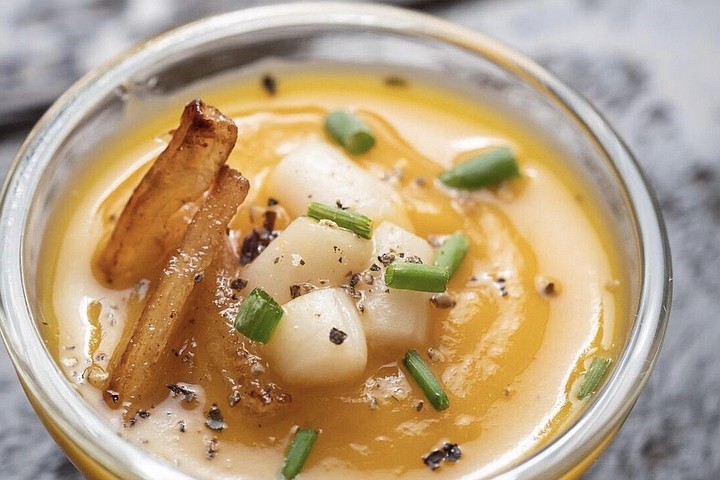 Facebook
Facebook
 X
X
 Instagram
Instagram
 TikTok
TikTok
 Youtube
Youtube

Q: What do Lou Cooperhouse and Winston Churchill have in common?
A: They both believe in growing only the part of the chicken or fish or beef you actually want to eat.
Amazingly, Churchill had this idea 90 years ago. “We shall escape the absurdity of growing a whole chicken, in order to eat a breast or a wing, by growing these parts separately, under a suitable medium,” the Great Man wrote in 1931.
A century later, here in San Diego, Lou Cooperhouse looks like he’s making that exact miracle happen, except with fish. He has found out how to create “whole-muscle, cell-based seafood products, in which living cells are isolated from fish tissue, placed into culture media for proliferation, and then assembled into great-tasting fresh and frozen seafood products.”

Now he’s creating a 40,000-square-foot San Diego facility to actually make this happen. “We will be able to create real seafood, but without mercury, without micro plastics, or environmental pollutants, simply fish cells multiplying in stainless steel containers like beer vats until they can be combined and shaped into the bits of fish we’d recognize.” And because it’s still an expensive process, Cooperhouse’s company, BlueNalu (“Nalu” is Hawaiian for “ocean waves,” and “go mindfully with the flow”), is starting with recreating about the most expensive fish in the Pacific, the blue fin tuna. One sold for $1.8 million the other day in Tokyo. “But with our system, blue fin costs the same to produce as pollack. So we may start with mahi mahi, then it might be bluefin tuna, then a red snapper, then a mahi mahi that’s targeted for use in poke or ceviche, maybe in the form of a cube, or a filet, and your bluefin tuna might be in the form of a sashimi-grade strip. So we’re targeting products we can literally manufacture based on consumer demand.”
He admits costs right now are “extremely expensive,” but will become “clearly affordable over time, because for the first time we’re demonstrating large-scale production and bringing the economies of scale into this industry. And while our prices will come down, with the increasing shortage of ocean fish stock, the price of traditional fish can only go up. But [with cellular aquaculture] we could keep more fish in the ocean, and really help take the pressure off the [natural] system.”
Cooperhouse believes he’s got a tiger by the tail, on the scale of, say, inventing the PC, or the World Wide Web. Why set up in San Diego? “It’s all about the San Diego workforce, and the tremendous talent we have here.” And appropriate talent. “Tissue engineering, cell biology, bio-pharma processing, on and on. And also a deep San Diego heritage in the seafood industry.”
Cooperhouse remembers how he came to his aha! moment. “I had spent 35 years in the food industry, but I was increasingly out there giving a lot of speeches about food trends and consumers’ interest in sustainability. Initially, plant-based foods were the focus. And then in the early 2010s, the proof-of-concept happened with cell-based [food]. At the Hawaii Agricultural Foundation, I was saying, ‘Yes, Impossible Burgers, but why’s nobody working on seafood?! That’s the biggest opportunity!’
“Sure enough there was a person in the audience from a venture-capital firm. He said, ‘We’ve got to talk. You’ve just made the case for a very disruptive company.’”
A few months later, in 2017, Blue Nalu launched. “Now we have $84.5 million in funding, and commitments worldwide.”


Q: What do Lou Cooperhouse and Winston Churchill have in common?
A: They both believe in growing only the part of the chicken or fish or beef you actually want to eat.
Amazingly, Churchill had this idea 90 years ago. “We shall escape the absurdity of growing a whole chicken, in order to eat a breast or a wing, by growing these parts separately, under a suitable medium,” the Great Man wrote in 1931.
A century later, here in San Diego, Lou Cooperhouse looks like he’s making that exact miracle happen, except with fish. He has found out how to create “whole-muscle, cell-based seafood products, in which living cells are isolated from fish tissue, placed into culture media for proliferation, and then assembled into great-tasting fresh and frozen seafood products.”

Now he’s creating a 40,000-square-foot San Diego facility to actually make this happen. “We will be able to create real seafood, but without mercury, without micro plastics, or environmental pollutants, simply fish cells multiplying in stainless steel containers like beer vats until they can be combined and shaped into the bits of fish we’d recognize.” And because it’s still an expensive process, Cooperhouse’s company, BlueNalu (“Nalu” is Hawaiian for “ocean waves,” and “go mindfully with the flow”), is starting with recreating about the most expensive fish in the Pacific, the blue fin tuna. One sold for $1.8 million the other day in Tokyo. “But with our system, blue fin costs the same to produce as pollack. So we may start with mahi mahi, then it might be bluefin tuna, then a red snapper, then a mahi mahi that’s targeted for use in poke or ceviche, maybe in the form of a cube, or a filet, and your bluefin tuna might be in the form of a sashimi-grade strip. So we’re targeting products we can literally manufacture based on consumer demand.”
He admits costs right now are “extremely expensive,” but will become “clearly affordable over time, because for the first time we’re demonstrating large-scale production and bringing the economies of scale into this industry. And while our prices will come down, with the increasing shortage of ocean fish stock, the price of traditional fish can only go up. But [with cellular aquaculture] we could keep more fish in the ocean, and really help take the pressure off the [natural] system.”
Cooperhouse believes he’s got a tiger by the tail, on the scale of, say, inventing the PC, or the World Wide Web. Why set up in San Diego? “It’s all about the San Diego workforce, and the tremendous talent we have here.” And appropriate talent. “Tissue engineering, cell biology, bio-pharma processing, on and on. And also a deep San Diego heritage in the seafood industry.”
Cooperhouse remembers how he came to his aha! moment. “I had spent 35 years in the food industry, but I was increasingly out there giving a lot of speeches about food trends and consumers’ interest in sustainability. Initially, plant-based foods were the focus. And then in the early 2010s, the proof-of-concept happened with cell-based [food]. At the Hawaii Agricultural Foundation, I was saying, ‘Yes, Impossible Burgers, but why’s nobody working on seafood?! That’s the biggest opportunity!’
“Sure enough there was a person in the audience from a venture-capital firm. He said, ‘We’ve got to talk. You’ve just made the case for a very disruptive company.’”
A few months later, in 2017, Blue Nalu launched. “Now we have $84.5 million in funding, and commitments worldwide.”
Comments